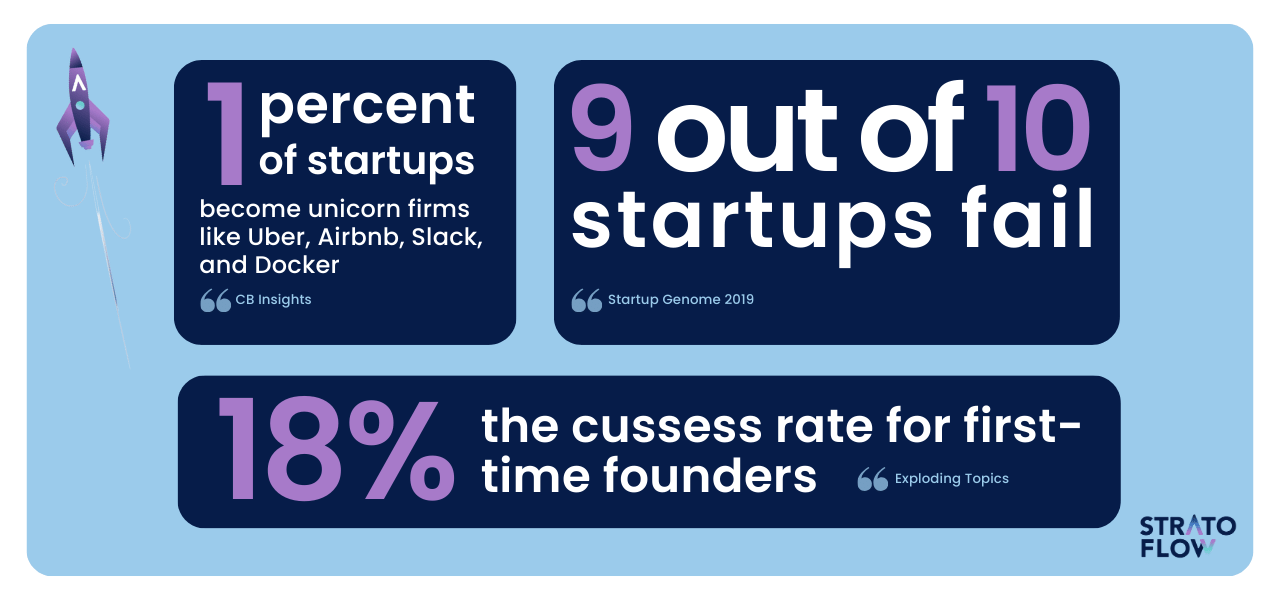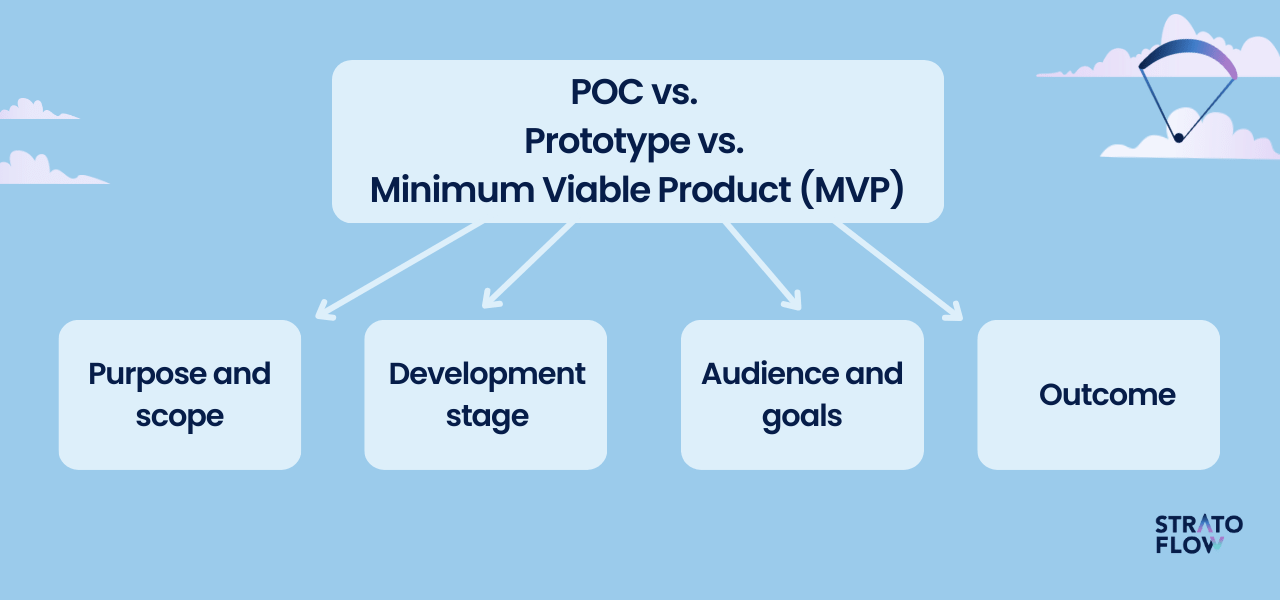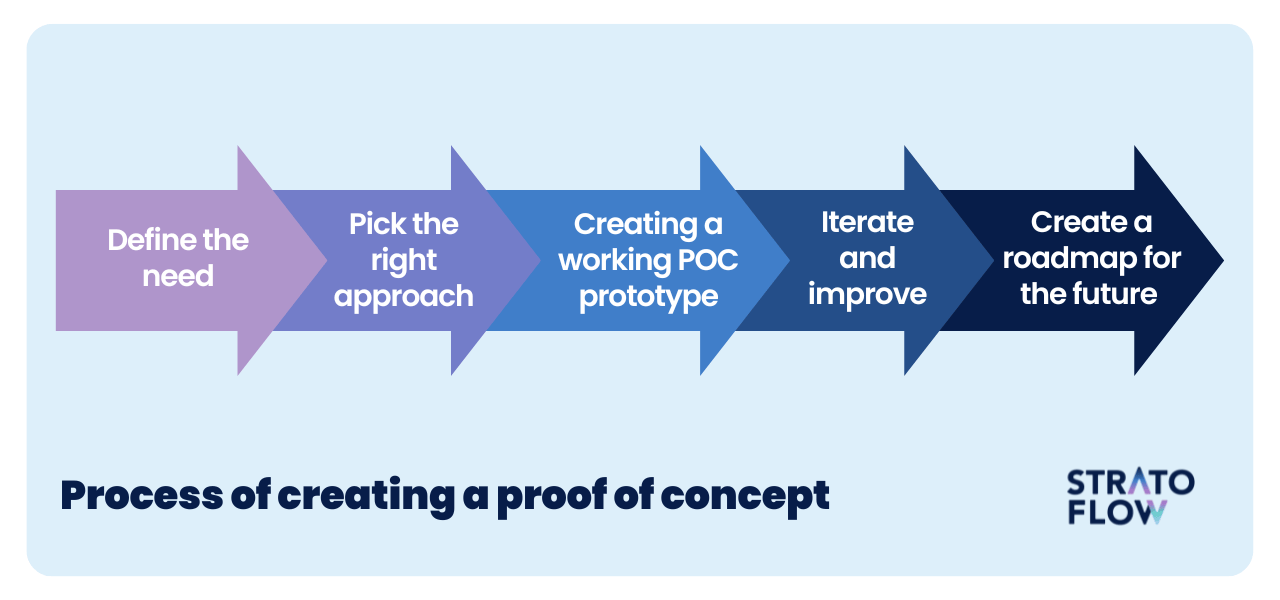
What Is a POC and How to Create a Proof of Concept?
In today’s competitive digital marketplace, only the most innovative ideas succeed, and mediocrity is the fast track to irrelevance. But how do you ensure that your brilliant concept will hold up in the real world?
Enter the Proof of Concept (POC) – the tool that lets you test the waters before fully committing to custom software development.
In this article, we’ll demystify the POC, explain its business significance, and guide you through the complexities of creating one. Whether you’re just thinking about starting a SaaS company, actively developing a side project on your own, or have solid plans to create a game-changing application, this article is a must-read for you!
What is a POC?
Picture this: You have a brilliant idea for a brand-new software project, a project development initiative that promises to revolutionize the industry and open up previously untapped areas of business. A real opportunity.
But now comes the first serious challenge: How do you convince stakeholders, investors, and most importantly, your own product development team that your vision is not just a pipe dream, but a tangible and viable business opportunity?
Enter the POC, which is short for Proof of Concept.

Proof of concept, or POC for short, is a preliminary, small-scale prototype created to assess the feasibility and viability of a larger initiative, often referred to as the final project.
The concept of proof of concept projects is present in various types of businesses, from project management tools, drug development to e-commerce and, most importantly, custom software development – and that’s what we’re going to focus on today.
A proof of concept in software development serves as a practical demonstration that a concept or initial idea can be effectively implemented using the chosen technology stack and methodologies, a clear example of concept definition in action. You can basically think of POC as clinical trials for a software product.
How is Proof of Concept designed?
A successful POC is not designed to be fully functional software but rather aims to prove that the idea can realistically be developed into a working software product using the tangible and intangible resources available.
A proof of concept is designed to validate key assumptions on a target audience, test critical functionality that requires out-of-the-box thinking, and evaluate potential risks before investing significant resources into a full-scale development effort.
It’s a virtually risk-free learning experience that can greatly benefit your business, as it is one of the best practices in software development projects, SaaS business development, and startup management.
This phase typically involves a minimal investment of time and resources to build a basic version of the software, just enough to prove its technical feasibility and demonstrate its value.
That’s the most important aspect of a good POC – using as little budget as possible to test initial assumptions about our business idea.
After all, the less money we spend on a given proof of concept, the more of these “experiments” we can test. And the more ideas that are properly tested and validated, the greater the chances of commercial success for our SaaS company, application, or other software product.
[Read also: Power of Cloud Computing Scalability: Empowering Businesses to Scale with Ease]
Importance of POC in the product development process
You might be surprised at how many startup ideas fail and never get off the ground.
Companies and entrepreneurs often jump straight into project development to get their solutions to market as quickly as possible, burning through their budgets in the process.
After a while, it may turn out that our brilliant idea requires a lot more resources than they initially thought, or that the concept is simply not feasible.
That’s why proof of concept projects are so important in the discovery phase of any custom software development process.

By demonstrating a working model or prototype, entrepreneurs can ensure that the idea is even possible before working on something that can be released to the general public.
Proof-of-concept projects can also be used to attract potential investors and secure funding more effectively because the POC reduces the perceived risk associated with the project – you’re not presenting a dry PowerPoint to a VC firm, you’re presenting something real that proves your concept has some chance of success.
In addition, similar to early MVPs, POCs allow companies to test their product idea with a select group of users in the target market before full-scale development. This very early valuable feedback allows for adjustments to better align the product with market demand, reducing the risk of building a product that does not resonate with customers.
[Read also: What’s the Future of Digital Transformation and Its Trends? An Expert’s Point of View]
POC vs. Prototype vs. Minimum Viable Product (MVP)
When researching the topic, you may come across three key terms: POC, which we’ve already covered in detail, but also Prototypes and Minimum Viable Product (MVP).
What’s the difference? Are they three different things, or just an evolution of a single, bare-bones software product?
Let’s answer these questions, as they are crucial to gaining a deeper understanding of the entire product development process.
We will do this by comparing these three applications in four key categories: purpose and scope, stage of development, target audience, and intended outcomes.

Purpose and scope
- Proof of Concept (POC) – The primary purpose of a POC is to determine the technical feasibility of the project idea. It aims to answer the question, “Can we even build it?” A proof of concept is a small, focused project that typically explores a specific technical aspect or feature to validate whether it’s feasible or not.
- Prototype – A prototype goes beyond technical feasibility and aims to answer the question, “What will it look like?” It focuses on creating a visual representation of the product, often emphasizing the user interface and user experience. Prototypes are used to gather feedback and refine the design.
- Minimum Viable Product (MVP) – An MVP is a functional version of the product that includes a minimal set of features required to address a specific problem or meet a particular need. It goes beyond technical feasibility and design, aiming to answer the question, “Does it solve the problem and provide value to users?”
Development stage
- POC – Typically, POCs are created at the earliest stage of a project, even before extensive development efforts begin. They are used to test specific technical components or concepts and see if they are possible to successfully implement.
- Prototype – Prototypes are generally developed after a successful POC. They are used to explore the user interface and gather feedback on design aspects. Prototypes can be low-fidelity (paper sketches or wireframes) or high-fidelity (interactive mockups).
- MVP – Minimum viable product is the most robust project of the bunch. It represent a functional product with the core features needed to provide the most value to early users. It may lack the more advanced functionalities and be a little bare-bone but the core value proposition is already here.
Audience and goals
- POC – The audience for a POC is often internal, including technical teams and sometimes stakeholders. The goal is to confirm whether a specific technical idea or component can be successfully developed and implemented.
- Prototype – Prototypes are often shared with a broader audience, including potential users and investors, to gather feedback on the user interface and user experience. The goal is to refine the product’s design.
- MVP – MVPs are launched to a broader audience, including early adopters or a target user base. The goal is to validate the product’s market fit and collect user feedback for further improvements.
Outcome
- POC – The outcome of a successful POC is confirmation that the technical idea is feasible. It may or may not lead to the development of a full product – that will depend on more thorough market research.
- Prototype – The outcome is a visual representation of the product’s design and user interface, helping to refine the user experience and gather input for further development.
- MVP – The outcome is a functional product that can be used by real users to solve a specific problem. It serves as the foundation for iterative development and improvement.
So to sum it all up, POCs are meant to verify the technical feasibility of the product idea, prototypes focus on design and user experience, while MVPs aim to provide a functional solution that addresses real user needs and validates market demand. These stages often follow a logical progression in the software development process.
[Read also: Application Development Guide: Types of Applications and Development Methodologies]
10 benefits of using proof of concept in software development process
The process of creating a proof of concept in software development should result in a comprehensive concept document outlining the project’s requirements and objectives, as well as delineating the roles and processes assigned to each project team member.

Validation of initial assumptions
The most important aspect of a Proof of Concept (POC) is its ability to validate initial assumptions about a software product, particularly from a technical perspective based upon set success criteria.
For example, if a project assumes that a new machine learning algorithm can accurately classify data in real time, a POC can be created to evaluate the algorithm’s actual performance using sample data. By building a POC, developers gain empirical evidence that either confirms or refutes their initial technical assumptions. If the POC successfully demonstrates the desired functionality or performance, it provides confidence in the feasibility of the chosen approach.
Risk mitigation
Building a proof of concept acts as a preemptive strike against potential technical pitfalls.
By following a POC process, you’re essentially conducting a controlled experiment to assess whether your innovative software concept can be turned into a working reality. Because POCs are typically smaller and require fewer resources than full development, they help save valuable time and budget. If the POC shows that the concept is not technically feasible, you can pivot or abandon the project without significant loss.
Cost savings
This point is closely related to the previous one.
POCs are typically small projects with limited resources and a well-defined scope and purpose, making them cost-effective compared to full-scale development. A well-executed POC acts as a cost-effective risk management tool. It helps organizations validate their software product concepts, make informed decisions, and optimize resource allocation.
Improved decision-making process
A successful proof of concept provides data-driven insight into the feasibility of your software design.
It enables you to make informed decisions about whether to continue the project, pivot to a different approach, or abandon it altogether. This efficient decision-making helps you avoid wasting resources on unprofitable ideas.

Assured alignment with business goals
Creating a Proof of Concept (POC) ensures business alignment by validating that the proposed software solution or product concept is aligned with the organization’s strategic goals and can deliver the intended value. It acts as a practical demonstration, providing tangible evidence that the project is on the right track.
Accelerated software development
A Proof of Concept can expedite the software development process by providing a clear roadmap and validating critical technical components early on.
It helps developers focus on proven concepts, reducing the time spent on speculative or unviable ideas.
Stakeholder Buy-In
POCs are valuable communication tools that make it easier to gain support from stakeholders, investors, and decision-makers. Demonstrating a working prototype can generate enthusiasm and confidence in the project.
Innovation and experimentation
Why do companies do proof of concept projects?
Because they want to test a concept that no one else has implemented.
That’s the main reason why POCs are a key driver of innovation in software development. POCs encourage experimentation and exploration of new technologies, approaches, and ideas, fostering a culture of innovation within development teams.

Focus on critical features
Proof of Concept projects help companies focus on critical features by providing a clear framework for concept testing and validating the most important aspects of a software concept or product idea. This focused approach ensures that resources and attention are focused on the core functionality and components critical to the success of the software, resulting in a more efficient development process.
Early issue identification
Finally, POCs often uncover technical or design issues early on, reducing the likelihood of major problems in software development lifecycle.
POCs typically focus on a specific aspect or feature of a software project. By isolating and thoroughly testing that element, developers can uncover issues and challenges associated with it early in the development cycle.
How to create a proof of concept in 5 steps?
The process of creating a proof of concept in software development should result in a comprehensive documentation outlining the project’s requirements and objectives, as well as delineating the roles and processes assigned to each stakeholder.
Let’s now cover the 5-step process of creating a proper proof of concept project.

Step 1: Define the need
Every project starts with a clear goal, and that includes a POC.
The first step in creating a proof of concept is to clearly define the need or problem your project is trying to solve.
Ask yourself questions such as What are the key goals we are trying to achieve? What challenges or opportunities are we trying to explore? What is our time frame? What resources do we have at our disposal? What part of our concept is truly unique from a technical standpoint?
Engage team members and conduct market research to gain a full understanding of the problem. By carefully defining the need, you lay a solid foundation for the rest of the POC process.
Step 2: Pick the right approach
After establishing clear goals, engage in a collaborative brainstorming session with your development team to explore potential solutions to the identified problems and pain points.
Identify all viable approaches to address these issues. Create a comprehensive map of these solutions, taking into account considerations such as your budget, timeframe, and a competitive analysis, including what your competitors already offer and whether you can build on their offerings. This phase will help resolve some of the initial uncertainties. Be sure to include a technical expert in this discussion to provide insight into feasibility and guide decisions about what can and cannot be accomplished.
Step 3: Create a working POC prototype
With a clear need and approach in mind, you move on to creating a working POC prototype.
This is where the rubber meets the road and you turn your concept into a tangible reality. Develop a scaled-down version of your software or solution that encapsulates the core features and functionality. Keep the POC focused and avoid unnecessary complexity – the goal is to test the technical feasibility of your idea, not to develop a full-fledged MVP.

Step 4: Iterate and improve
Once you have a working POC prototype, it’s time to iterate and improve.
Initial tests should verify the feasibility of the project, but they are sure to leave plenty of room for further improvements. Iterate on the POC to address any issues and make further technical refinements. This iterative process is critical to fine-tuning your concept and ensuring that it meets your goals and requirements.
Step 5: Create a roadmap for future development
After refining your POC, it’s essential to create a roadmap for future development.
Based on the findings and results of the POC, outline the next steps for your project. Determine whether the concept should move to full development, require additional POCs, or undergo further validation. Develop a strategic plan that includes timelines, resource allocation, and milestones for the continued development of the project.
Conclusion
In the world of custom software development and SaaS applications, the strategic implementation of a proof of concept can significantly impact a company’s trajectory. More than just a preliminary test, a well-designed proof of concept is a cornerstone of informed decision-making and a critical step in the product development process. By using a proof of concept effectively, companies can mitigate risk, optimize resource allocation, and validate their ideas, turning abstract concepts into practical, viable solutions.
A proof of concept is not just a phase in the development process; it’s a fundamental strategy that enables innovators and entrepreneurs to demonstrate the feasibility and potential of their ideas. The success of a proof of concept can attract investors, secure funding, and build confidence among stakeholders. In addition, the lessons learned from a proof of concept can guide future development, ensuring that the project is aligned with market needs and business objectives.
In summary, the proof of concept is an indispensable tool in the modern business landscape. It provides a framework for testing, learning, and refining ideas before significant investments are made. A robust proof of concept can be the difference between a successful project and one that never gets off the ground. Investing time and effort into developing a strong proof of concept isn’t just smart, it’s essential for any business that wants to innovate and succeed in the competitive world of software development and technology.
Related Posts
- How to Build an Inventory Management System: Key Steps and Tips
- How to Build a Document Management System: Alternative Approach
- Online Shopping Recommendations – Introducing Them to Your Business
- Amazon Product Recommendation System: How Does Amazon Algorithm Work?
- Movie Recommendation Systems: A Business Guide
Thank you for taking the time to read our blog post!
